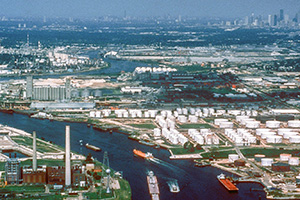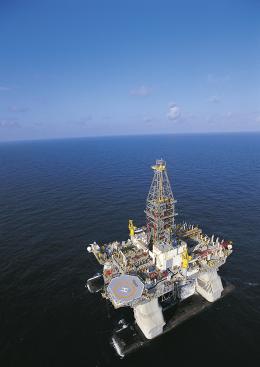By Zain Shauk, Houston Chronicle
A set of barges crashed into an electrical tower Sunday in the Port of Houston, prompting the U.S. Coast Guard to shut down most of the nation’s second-largest maritime shipping complex, possibly until Wednesday.
A towing vessel pushing three barges of scrap metal through the Houston Ship Channel about 6 a.m. hit a 300-foot-tall electrical tower, which carries lines across the artery, said Petty Officer Richard Brahm, a spokesman for the Coast Guard. No injuries were reported.
The crash happened at the narrowest point in the waterway, leaving three-fourths of the port’s terminals inaccessible.
“Maybe if it was wider we could have got boats around it, but it’s not, so it’s a logistical problem,” Brahm said. “It’s a bad place for it to happen.”
There was no risk of electricity-related injuries or effects to the power grid, which is owned by Houston-based CenterPoint Energy, because lines in the area were deactivated prior to the crash for maintenance work, said Penny Todd, a spokeswoman for the company.
CenterPoint was in the process Sunday of moving equipment needed to clear the steel tower and cables from the waterway — work the company expects will be completed Wednesday, she said.
The 25-mile-long port complex is a major economic engine for the region and in 2009 handled more waterborne tonnage than any port in the country, according to the Port of Houston Authority.
About 60 ships carrying $322 million in goods and resources — ranging from crude oil to finished products in containers — move through the port each day, said Chief Warrant Officer Lionel Bryant, a spokesman for the Coast Guard.
19 miles closed
Items shipped through the Port of Houston move to and from destinations in every state, which could mean delays for companies with vessels in the water.
Those ships will have to drop anchor and wait until the steel electrical tower, which was propped up by the barges after the accident, is removed.
At least eight ships were waiting in an anchoring area outside the port after the crash. Five others were waiting to leave.
The Coast Guard closed 19 miles out of the 54-mile-long ship channel, leaving more than 100 terminals — including those for oil giants Shell and Valero — cut off from the sea.
Further delays possible
The few accessible terminals are mostly for container ships and will not be usable by most companies that would need other infrastructure for loading and unloading or that had planned to arrive at terminals north of the crash site, said Tom Pace, presiding officer of Houston Ship Pilots, a labor association.
Three days of backups could result in further delays, even as traffic begins moving through the port again, Pace said.
“It’s going to take probably three days to get everything back to normal after that,” he said.
Crew members from the towing vessel, the T/V Safety Quest, were removed from the boat and tested for drugs and alcohol.
It was unclear how the accident occurred, but the tower’s location has long been known to ship pilots who work in the port, Pace said.
It was one of six towers in the channel, but was the closest to the preferred waterway for traffic.
“The one problem is the tower’s really close to the navigable channel,” Pace said. “That’s probably one of the reasons it had happened.”
Staff writer Sarah Raslan contributed to this report.
zain.shauk@chron.com


.jpg)